For the 2025 school year, there are 2 public elementary schools serving 269 students in Julian Union Elementary School District. This district's average elementary testing ranking is 5/10, which is in the bottom 50% of public elementary schools in California.
Public Elementary Schools in Julian Union Elementary School District have an average math proficiency score of 27% (versus the California public elementary school average of 35%), and reading proficiency score of 35% (versus the 45% statewide average).
Minority enrollment is 58% of the student body (majority Hispanic), which is less than the California public elementary school average of 79% (majority Hispanic).
Overview
This School District
This State (CA)
# Schools
2 Schools
7,700 Schools
# Students
269 Students
3,822,920 Students
# Teachers
15 Teachers
174,006 Teachers
Student : Teacher Ratio
18:1
18:1
District Rank
Julian Union Elementary School District, which is ranked #1127 of all 1,925 school districts in California (based off of combined math and reading proficiency testing data) for the 2021-2022 school year.
The school district's graduation rate of 30-34% has stayed relatively flat over five school years.
Overall District Rank
#1049 out of 1941 school districts
(Bottom 50%)
(Bottom 50%)

Math Test Scores (% Proficient)
25-29%
33%
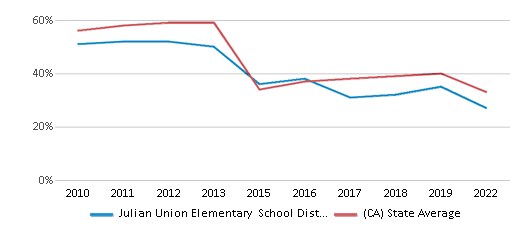
Reading/Language Arts Test Scores (% Proficient)
35-39%
47%

Science Test Scores (% Proficient)
11-19%
29%
Graduation Rate
30-34%
87%
Students by Ethnicity:
Diversity Score
0.64
0.64
# American Indian Students
8 Students
16,785 Students
% American Indian Students
3%
1%
# Asian Students
n/a
454,357 Students
% Asian Students
n/a
12%
# Hispanic Students
113 Students
2,114,366 Students
% Hispanic Students
42%
55%
# Black Students
n/a
189,461 Students
% Black Students
n/a
5%
# White Students
114 Students
787,389 Students
% White Students
42%
21%
# Hawaiian Students
2 Students
15,077 Students
% Hawaiian Students
1%
n/a
# Two or more races Students
32 Students
240,557 Students
% of Two or more races Students
12%
6%
Students by Grade:
# Students in PK Grade:
-
83
# Students in K Grade:
42
519,574
# Students in 1st Grade:
30
396,601
# Students in 2nd Grade:
25
414,466
# Students in 3rd Grade:
28
416,628
# Students in 4th Grade:
31
426,360
# Students in 5th Grade:
30
430,582
# Students in 6th Grade:
25
432,936
# Students in 7th Grade:
33
312,207
# Students in 8th Grade:
25
312,649
# Students in 9th Grade:
-
44,929
# Students in 10th Grade:
-
37,487
# Students in 11th Grade:
-
37,249
# Students in 12th Grade:
-
41,169
# Ungraded Students:
-
-
District Revenue and Spending
The revenue/student of $23,595 is higher than the state median of $19,974. The school district revenue/student has stayed relatively flat over four school years.
The school district's spending/student of $16,372 is less than the state median of $18,396. The school district spending/student has stayed relatively flat over four school years.
Total Revenue
$6 MM
$116,387 MM
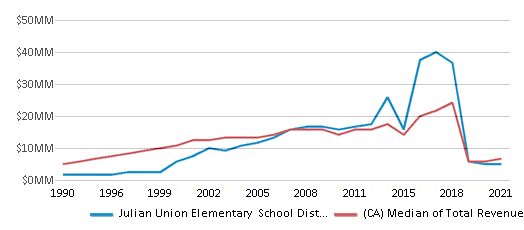
Spending
$4 MM
$107,188 MM
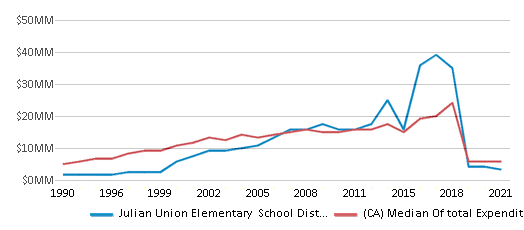
Revenue / Student
$23,595
$19,974
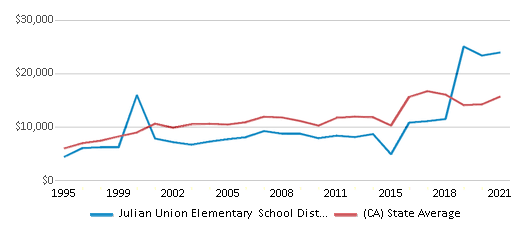
Spending / Student
$16,372
$18,396
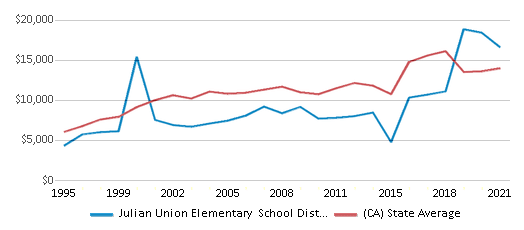
Best Julian Union Elementary School District Public Elementary Schools (2025)
School
(Math and Reading Proficiency)
(Math and Reading Proficiency)
Location
Grades
Students
Rank: #11.
Julian Junior High School
(Math: 30-34% | Reading: 35-39%)
Rank:
Rank:
6/
Top 50%10
1704 Cape Horn Ave.
Julian, CA 92036
(760) 765-0661
Julian, CA 92036
(760) 765-0661
Grades: 6-8
| 83 students
Rank: #22.
Julian Elementary School
(Math: 20-24% | Reading: 30-34%)
Rank:
Rank:
4/
Bottom 50%10
1704 Cape Horn Ave.
Julian, CA 92036
(760) 765-0661
Julian, CA 92036
(760) 765-0661
Grades: K-5
| 186 students
Recent Articles

Year-Round Or Traditional Schedule?
Which is more appropriate for your child? A year-round attendance schedule or traditional schedule? We look at the pros and cons.

Why You Should Encourage Your Child to Join a Sports Team
Participating in team sports has a great many benefits for children, there is no doubt. In this article you will learn what those benefits are.

White Students are Now the Minority in U.S. Public Schools
Increasing birth rates among immigrant families from Asia and Central and South America, combined with lower birth rates among white families, means that for the first time in history, public school students in the United States are majority-minority. This shift in demographics poses difficulties for schools as they work to accommodate children of varying language abilities and socio-economic backgrounds.





